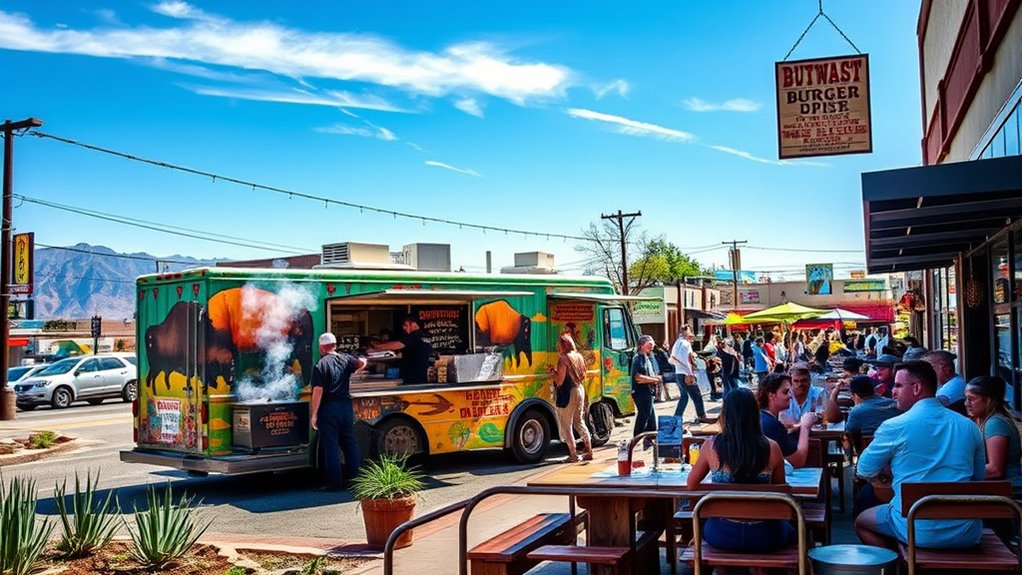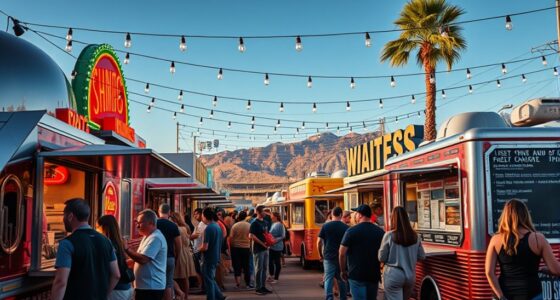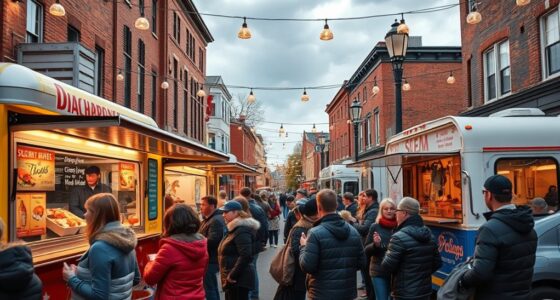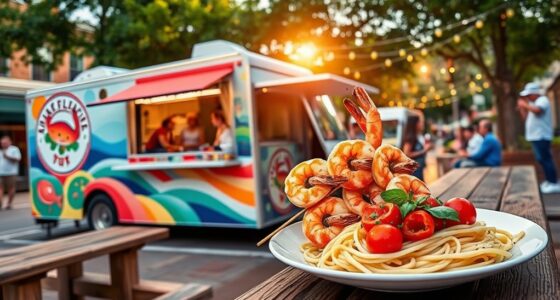Explore the vibrant Native and buffalo flavors in Rapid City’s food trucks, where traditional ingredients are fused with modern twists. From signature buffalo burgers and hearty stews to frybread and Indian tacos, these trucks celebrate indigenous culinary heritage. Social media helps showcase their bold dishes and connect communities. Supporting these vendors boosts Native entrepreneurship and promotes cultural pride. Keep exploring to uncover more about these authentic flavors and their cultural significance.
Key Takeaways
- Rapid City features Native food trucks offering regional frybread, buffalo dishes, and fusion cuisine that highlight indigenous culinary traditions.
- Sacred Storm Buffalo Food Truck emphasizes buffalo sourced from Native communities, supporting food sovereignty and sustainable practices.
- Signature dishes include buffalo burgers, stews, and frybread-based items like Indian tacos, blending traditional ingredients with modern flavors.
- Native-owned trucks actively promote cultural pride, community engagement, and storytelling through social media and local events.
- Food trucks serve as accessible venues for cultural revitalization, indigenous entrepreneurship, and sharing Native flavors with diverse audiences.
Celebrating the Native American Food Truck Festival in St. Paul
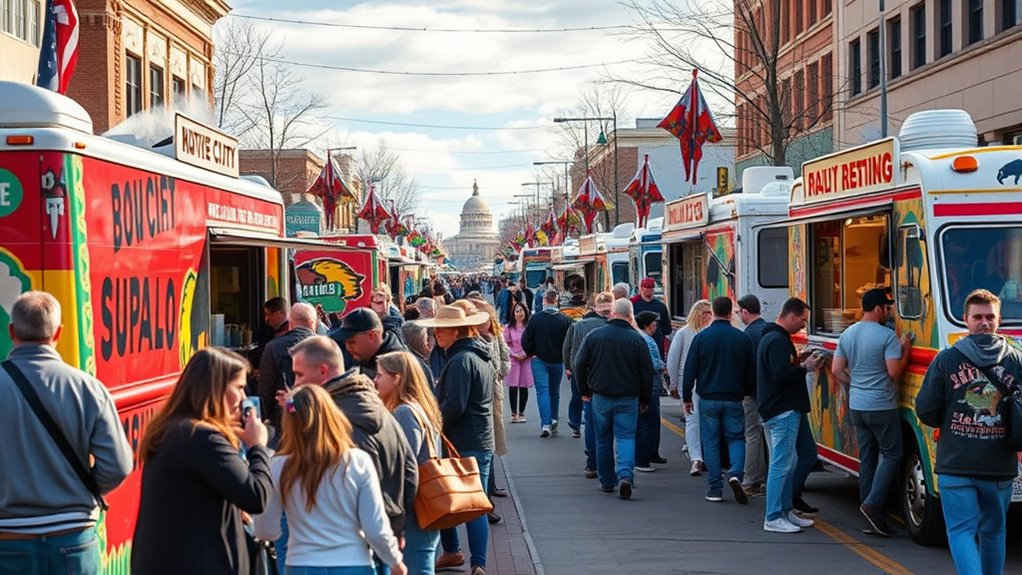
The Native American Food Truck Festival in St. Paul took place on July 5, 2025, at Harriet Island Regional Park along the Mississippi River. You could enjoy the event from 11 a.m. to 7 p.m., and best of all, it was free. Despite some morning rain and stormy weather, around 8,000 people showed up, enthusiastic to celebrate Native food culture and community. This marked Minnesota’s first Native American Food Truck Festival, set against the scenic riverbank that enhanced the outdoor experience. With a focus on Native culinary traditions, the festival brought together vendors showcasing regional frybread variations and fusion dishes. It was a vibrant gathering where culture and cuisine blended seamlessly, offering a memorable day of celebration for all attendees. Visitors also had the opportunity to explore hosting discount codes and other promotional offers to support local vendors and organizers.
Featured Culinary Vendors and Popular Dishes in Rapid City
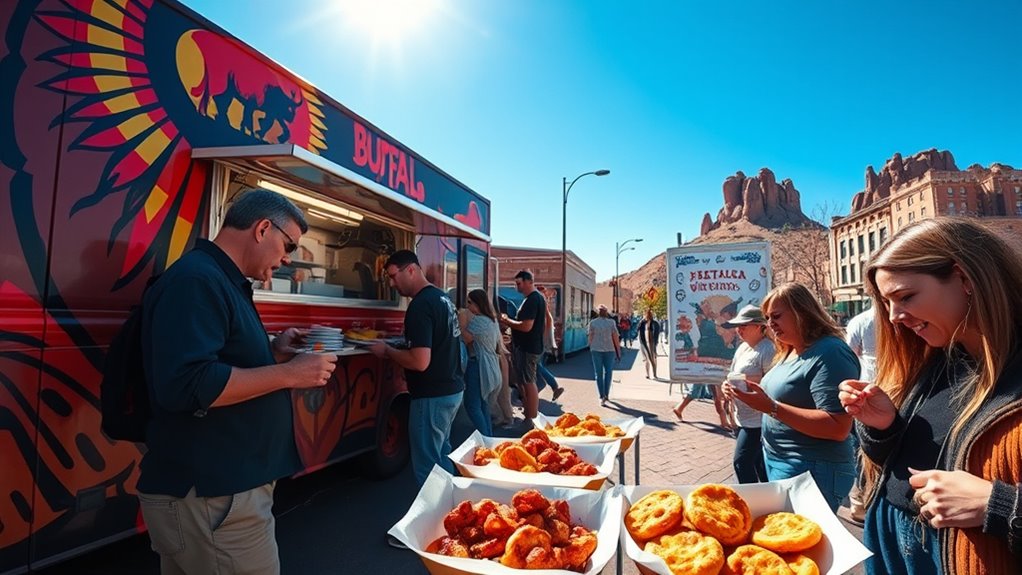
You’ll find signature buffalo dishes like lean, flavorful buffalo burgers and hearty stews that showcase local meat. Unique frybread offerings, often used as a base or side, add a native touch to many menus. These vendors blend traditional ingredients with modern twists, creating a memorable culinary experience in Rapid City. Event calendar features these food trucks at various local festivals and gatherings, making it easy to sample their specialties. Incorporating authentic Native ingredients into their recipes reflects the region’s rich culinary heritage and enhances the overall flavor profiles.
Signature Buffalo Dishes
In Rapid City, food trucks specializing in buffalo dishes showcase a vibrant blend of Native traditions and modern flavors. Sacred Storm Buffalo Food Truck offers signature meals featuring buffalo cooked on the Iron Hoof Grill, highlighting both traditional and contemporary techniques. Their menu emphasizes cultural revitalization and sustainable practices, with dishes that often incorporate local ingredients like chokecherry. Meanwhile, The Hangry Buffalo Food Truck is known for street-style buffalo fare, including tacos and burritos, with the famous Choke Cherry Bison Burger as a standout. These signature dishes celebrate Native heritage through bold flavors and authentic ingredients. Buffalo meat’s versatility shines in these offerings, from grilled steaks to hearty burgers and street food staples, making them essential highlights of Rapid City’s dynamic food scene. Sacred Storm Buffalo is set to open its retail store and food truck as part of a broader effort to promote Native food sovereignty and economic empowerment in the region. Additionally, the use of Native ingredients in these dishes underscores a growing movement to preserve and promote indigenous culinary practices.
Unique Frybread Offerings
Malissa’s Frybread Vendor has quickly become a standout in Rapid City’s food scene by offering innovative frybread dishes that celebrate Native traditions with a modern twist. You’ll find a daily-changing menu featuring creative options like Indian tacos topped with fresh, flavorful ingredients, chili-based specials such as the “res dog,” and sweet bites topped with strawberries, chocolate, or whipped cream. Imagine biting into:
- Warm frybread piled high with savory toppings.
- Crispy chili frybread with a spicy kick.
- Miniature dessert bites dusted with powdered sugar or drizzled with chocolate.
These dishes combine tradition and innovation, appealing to diverse tastes. The truck’s commitment to community, using local ingredients and supporting Native culture, makes each meal a flavorful experience that’s both authentic and inventive. Malissa’s Frybread is recognized as a highly recommended food spot with a strong community following, further elevating its reputation in Rapid City. Additionally, the use of traditional ingredients enhances the authenticity and flavor of each dish, connecting diners more deeply with Native culinary heritage.
The Significance of Buffalo in Indigenous Food Traditions
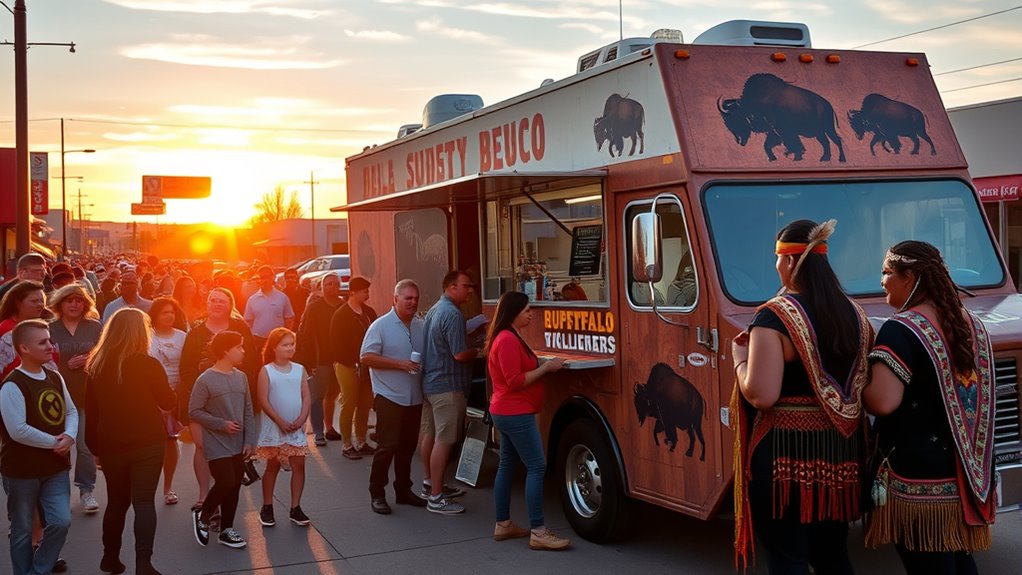
Buffalo holds an essential place in Indigenous food traditions, serving as both a primary source of sustenance and a symbol of cultural identity. It represents strength, resilience, and spiritual connection in many tribes. Buffalo are central to ceremonies like the Buffalo Dance, symbolizing abundance and gratitude. Every part of the animal is used, reflecting respect and resourcefulness. The practice of self-sustaining utilization underscores the deep respect Indigenous peoples have for the buffalo and their environment.
Spotlight on Malissa’s Frybread: A Local Favorite
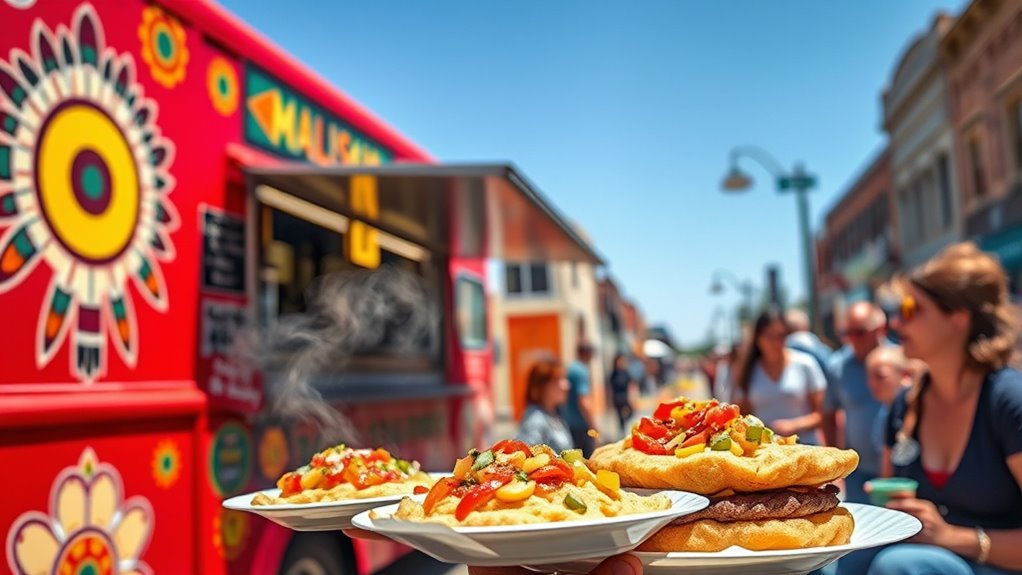
Malissa’s Frybread showcases the cultural importance of frybread in Native American traditions, offering more than just a meal—it’s a connection to heritage. As their social media presence grows, they attract a wider audience enthusiastic to experience authentic flavors with modern flair. This combination of tradition and digital outreach makes them a standout in Rapid City’s food scene. Located in Rapid City, SD, the food truck’s popularity is bolstered by community engagement and support from local residents. Their use of digital outreach helps preserve and promote Native American culinary heritage in contemporary settings.
Frybread Cultural Significance
Frybread’s cultural significance extends beyond its role as a traditional food; it embodies resilience, ingenuity, and the complex history of Native American communities. You can see this in how frybread:
- Represents survival, turning limited government rations like white flour, lard, and sugar into nourishing sustenance during displacement.
- Acts as a symbol of strength, linking generations through shared recipes and community gatherings.
- Reflects ongoing cultural pride, despite debates over its colonial origins and health impacts.
- The colorful cultural symbolism of frybread continues to evolve as communities embrace its significance while exploring healthier alternatives.
For many, frybread is more than a meal; it’s a powerful reminder of endurance through hardship. It’s woven into ceremonies, celebrations, and daily life, fostering community bonds and honoring Native heritage amidst a history of adversity.
Rising Social Media Presence
Thanks to its dynamic social media presence, Malissa’s Frybread has become a well-known fixture in Rapid City’s food scene. On TikTok, engaging videos showcase the food and customer praise, attracting followers and boosting popularity. Facebook keeps fans updated with weekly schedules and daily specials, while Instagram highlights menu variety and community interactions. YouTube features interviews with owner Malissa Walters, sharing personal stories and cultural insights. Regular posts keep the audience engaged, promoting loyalty and anticipation. Native customers frequently support and follow the truck, emphasizing its role in celebrating indigenous cuisine. Social media helps spread awareness of signature frybread dishes, daily specials, and diverse menu items. Malissa’s business began as a result of her efforts to support Indian taco sales and create a community space for Native cuisine, which further enhances its online visibility, fosters cross-cultural appreciation, and positions it as a leader in the Native food truck scene. Additionally, leveraging social media engagement has been instrumental in building a strong sense of community and cultural identity for the business.
Sacred Storm Buffalo: Promoting Food Sovereignty and Entrepreneurship
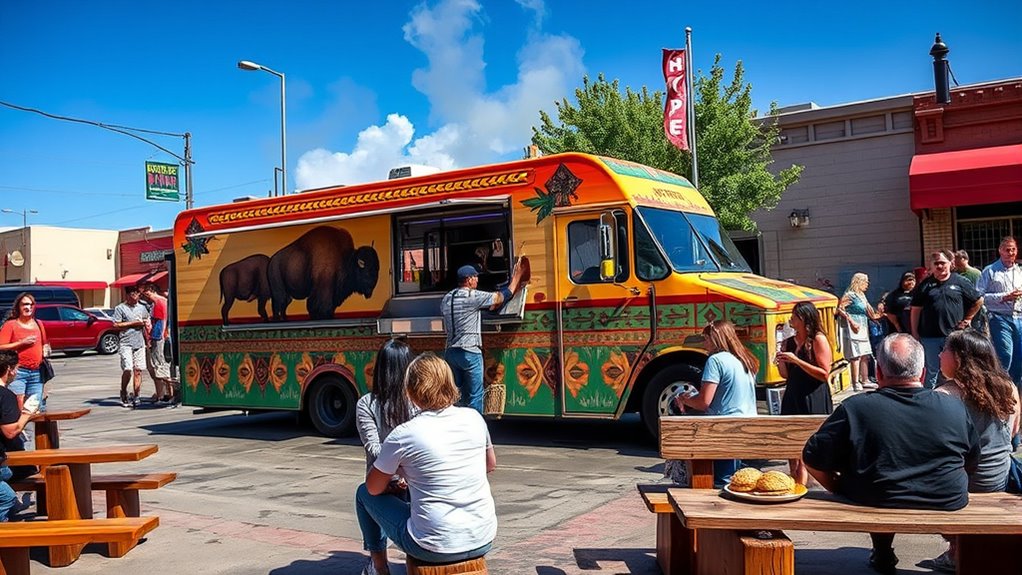
Sacred Storm Buffalo advances food sovereignty and entrepreneurship by empowering Native communities through Indigenous meat processing arts and sustainable practices. You can see this in action through:
- Training Native youth in buffalo butchery, processing, and entrepreneurial skills rooted in traditional practices.
- Supporting economic renewal with a $1.6 million Indigenous-designed loan, distributing 20,000 pounds of buffalo meat monthly to the Oglala Sioux Tribe.
- Developing retail and food truck channels, like the Iron Hoof Grill, serving buffalo-based meals and cultural stories.
- Employing a holistic SEO approach to increase visibility and engagement for their initiatives and community programs.
This approach restores connections to land and heritage, fostering independence and pride. You observe a thriving model of Indigenous-led growth that combines cultural revitalization with sustainable food access. Sacred Storm Buffalo truly champions community empowerment through buffalo.
How Food Trucks Support Cultural Revitalization and Community Building
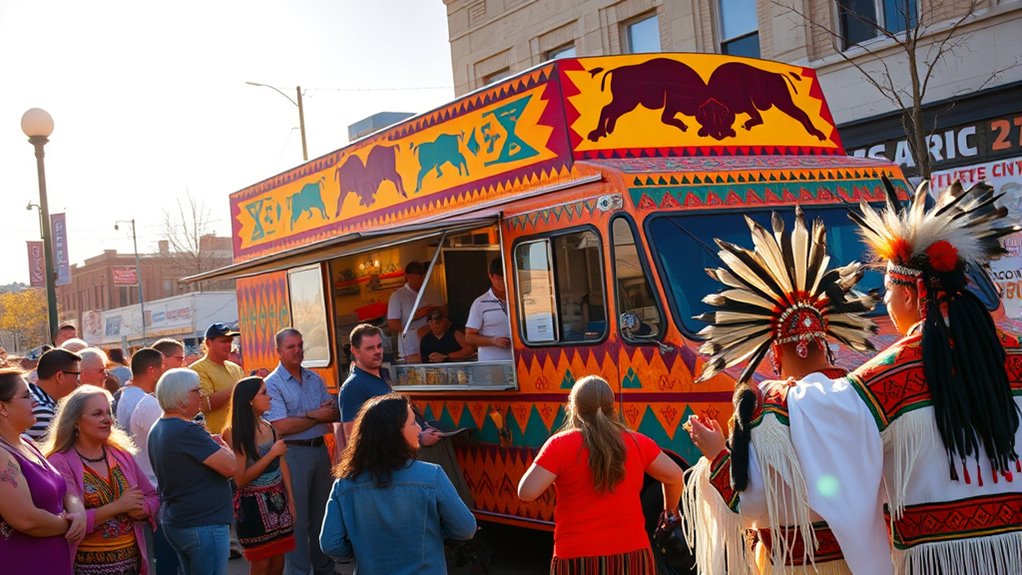
Food trucks play a vital role in supporting cultural revitalization and community building by serving as accessible platforms for sharing Native and buffalo flavors with broader audiences. When you visit these trucks, you help showcase indigenous culinary traditions and promote cultural pride. Many are minority-owned, fostering economic inclusion and local job creation, which strengthens community ties. These mobile venues facilitate cross-cultural exchange by blending traditional ingredients with modern techniques, making Native cuisine more approachable. They also serve as gathering spaces where diverse community members can share meals, engage in dialogue, and celebrate their heritage. Participating in local festivals and markets, food trucks revitalize public spaces and foster a sense of belonging, which can help preserve cultural traditions in the face of modern challenges. Additionally, they contribute to enhancing Cultural Intelligence by providing opportunities for intercultural learning and understanding within communities.
Growing Trends and Public Interest in Native and Buffalo Cuisine
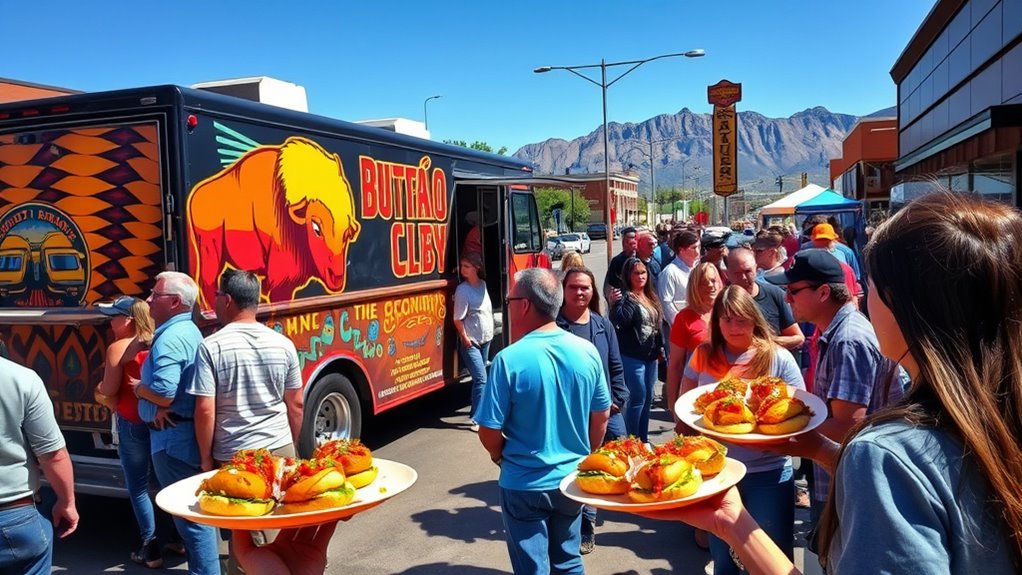
Social media has amplified interest in Native and buffalo cuisine, making these dishes more visible and appealing to a wider audience. Festivals and community events celebrate indigenous flavors, drawing crowds enthusiastic to try authentic, culturally significant foods. At the same time, culinary innovations in food trucks showcase modern takes on traditional recipes, fueling ongoing enthusiasm for native ingredients.
Social Media Influence
Have you noticed how social media platforms like Instagram and TikTok are fueling a surge of interest in Native and buffalo cuisine? You see, these platforms tell stories that highlight Indigenous and buffalo heritage food practices, sparking curiosity. Viral posts showcase:
- Traditional Native American dishes, making them look irresistible.
- Buffalo recipes emphasizing their health benefits and sustainability.
- Influencers sharing how buffalo meat fits into modern, wellness-focused diets.
This visual storytelling connects audiences emotionally to land stewardship and food sovereignty values. Native chefs and entrepreneurs use social media to educate, grow their followings, and demonstrate cultural significance. As a result, more people are discovering these flavors, boosting local food trucks and creating a broader movement that mixes heritage with health-conscious eating.
Festival Celebrations Rise
As Native and buffalo cuisine gain prominence, festival celebrations celebrating these traditions are attracting larger crowds and increasing public interest. Powwows and wacipis now draw thousands, showcasing traditional foods alongside dance and song. South Dakota Tribal Nations host more cultural events, boosting tourism and highlighting Native dishes featuring buffalo meat, emphasizing heritage and sustainability. Events like Indian Horse Relay and tribal fairs promote Native culinary traditions and storytelling, deepening visitor engagement. These festivals not only preserve culture but also energize local economies, with Native food vendors and food trucks gaining recognition.
| Festival Type | Focus | Impact |
|---|---|---|
| Powwows and Wacipis | Cultural celebrations | Draw thousands, promote Native foods |
| Tribal Cultural Events | Heritage and tourism | Grow visitor numbers |
| Native Food Vendors | Culinary storytelling | Enhance authenticity and engagement |
| Buffalo Dishes | Traditional cuisine | Drive public interest and sustainability |
Culinary Innovation Trends
Culinary innovation in Native and buffalo cuisine is gaining momentum as chefs and entrepreneurs blend traditional ingredients with modern techniques to create exciting, contemporary dishes. You might see:
- Venison chops infused with native herbs, grilled to perfection and served with wild rice pilaf.
- Bison tamales wrapped in corn husks, offering a fusion of Indigenous flavors and Mexican tradition.
- Wild rice soups topped with locally sourced buffalo meat, highlighting sustainable ingredients.
These dishes not only celebrate Indigenous heritage but also appeal to diverse palates. Native chefs are reimagining classic recipes while supporting community health and cultural storytelling. Food trucks and restaurants showcase these innovative menus, emphasizing authentic Native ingredients and sustainable sourcing, reflecting a growing public interest in Indigenous food sovereignty and culinary creativity.
The Role of Social Media in Elevating Native Food Truck Popularity
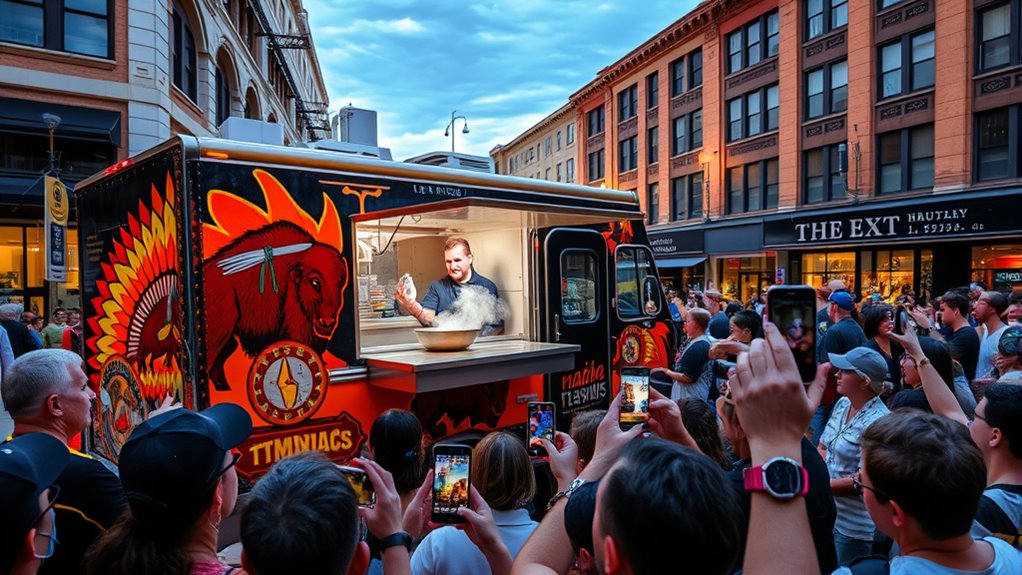
Social media plays a crucial role in boosting the popularity of Native food trucks by showcasing their unique flavors and cultural stories. With 68% of owners actively promoting their business online, platforms like Facebook (75%), Instagram (68%), and TikTok (35%) are essential tools. TikTok influencer marketing, used by 58% of food trucks targeting younger audiences, has led to direct sales increases for many. High-quality photos and viral videos help create a visual word-of-mouth reputation, attracting new customers. Posting during peak engagement times, such as lunch and early evening, maximizes visibility. Additionally, social media allows real-time updates on locations, menu specials, and customer feedback, fostering loyalty and community. 80% of successful marketing strategies include active participation at community events, which further amplifies their online reach and local presence. Overall, strategic online presence considerably enhances Native food trucks’ reach and popularity.
Native Food Trucks as Catalysts for Tourism and Economic Growth
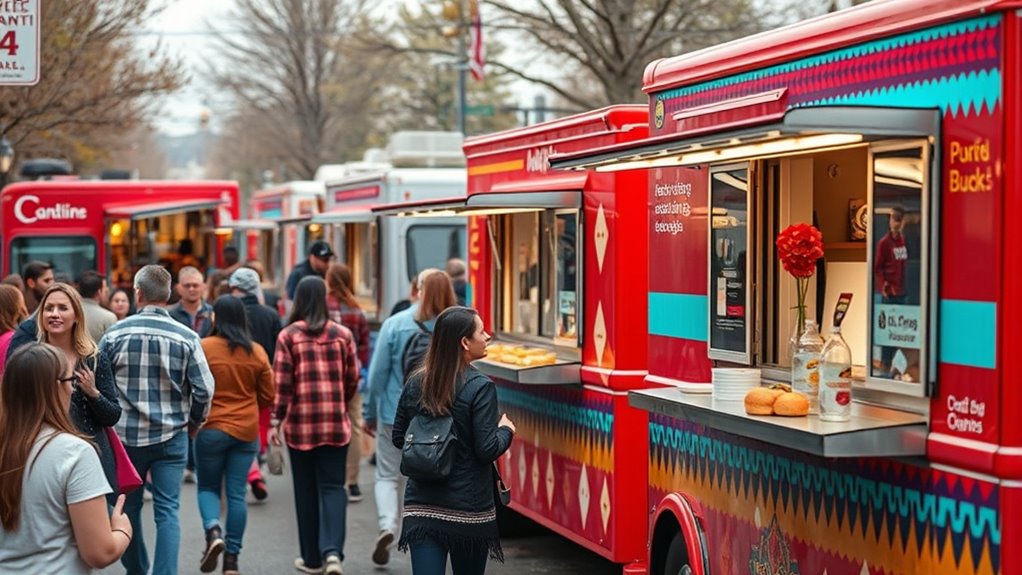
Native food trucks serve as powerful catalysts for tourism and economic growth in Rapid City by offering authentic Indigenous experiences that attract both locals and visitors. You can imagine: 1. Tourists savoring buffalo dishes at events like Indigenous Peoples’ Day, creating memorable cultural moments. 2. Visitors exploring outdoor markets where Native trucks showcase traditional foods, enhancing the city’s appeal. 3. Locals and tourists engaging directly with Native cuisine, fostering a deeper understanding of Indigenous heritage. These mobile eateries are more than food vendors — they’re incubators for Native youth training, sources of locally sourced buffalo, and drivers of self-determined economic sovereignty. By drawing crowds and supporting Indigenous entrepreneurship, Native food trucks boost tourism and generate essential economic opportunities for Indigenous communities. Indigenous-led organizations have increasingly supported Native food initiatives, helping to sustain and grow these culinary enterprises.
Preserving Heritage Through Mobile Food Experiences
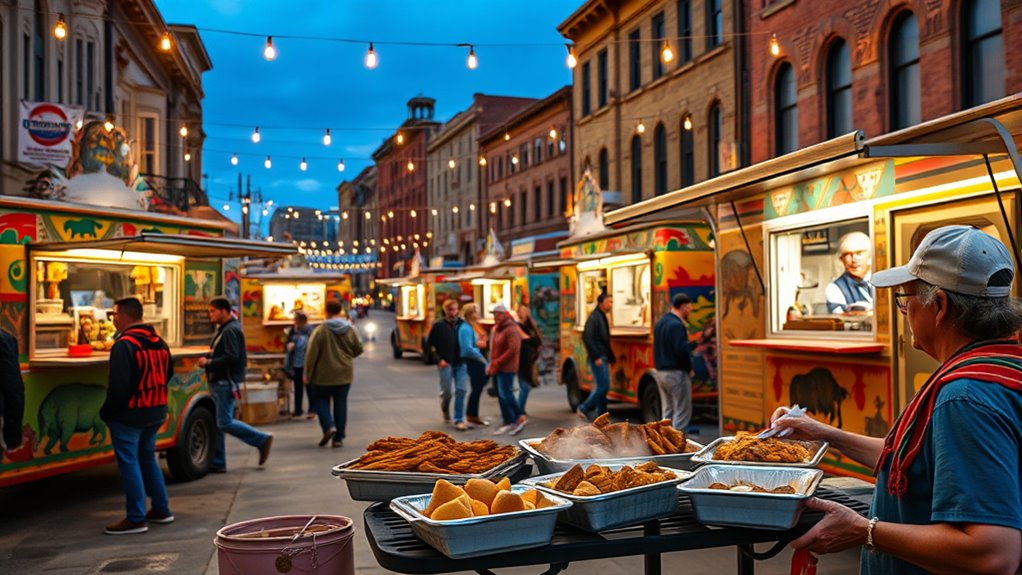
Mobile food experiences play a vital role in preserving Indigenous heritage by showcasing traditional ingredients and recipes in accessible, everyday settings. When you visit food trucks like Malissa’s Frybread, you see how dishes like frybread keep cultural traditions alive, attracting long lines and community gatherings. These trucks often incorporate heirloom and wild-harvested ingredients, ensuring authentic flavors and ancestral foodways endure. Knowledge of buffalo butchery and meat processing is passed through workforce development programs, fostering culinary continuity. By blending traditional recipes with modern techniques, these trucks make Indigenous cuisine approachable while honoring heritage. They also serve as educational platforms, sharing stories behind the dishes and promoting cultural awareness. In addition, the presence of these food trucks helps sustain Indigenous food systems and strengthen cultural ties in everyday life. Through these mobile experiences, you help preserve and celebrate Indigenous culinary traditions.
Frequently Asked Questions
How Do Native Food Trucks Source Their Ingredients Sustainably?
Native food trucks source their ingredients sustainably by partnering with local Native farms and ranches, ensuring meats like buffalo come from ethically managed herds. They forage wild plants and herbs, using traditional regional ingredients to reduce environmental impact. Collaborative vendor networks and community events strengthen local economies. They also focus on low-waste meat processing and support Indigenous food sovereignty, which promotes ecological balance, cultural preservation, and self-determined food systems.
What Training Do Indigenous Entrepreneurs Receive to Operate Food Trucks?
You receive extensive training to operate food trucks, including food safety, sanitation, and handling protocols through Certified Food Service Manager courses. You also learn about safe sampling, contamination prevention, and proper food labeling, often with guidance from SDSU Extension Food Safety Specialists. Additionally, you’ll get business support on permits, licensing, and operational setup, ensuring you meet both state and tribal regulations for a successful, compliant food truck venture.
How Do Food Trucks Incorporate Traditional Cooking Techniques?
You incorporate traditional cooking techniques by blending ancient methods with modern technology. Instead of relying solely on open fires, you use clay pots, wooden bowls, and adapted heat sources to mimic traditional practices. Dehydrating, fermenting, and simmering help develop authentic flavors and extend shelf life. This approach preserves indigenous methods, connects you to cultural roots, and creates a genuine culinary experience that honors your heritage while fitting today’s food truck environment.
What Challenges Do Native Food Trucks Face in the Industry?
You face challenges like limited access to startup funding and a smaller customer base due to fewer Native people in urban areas. Competition from cheap fast food trucks makes it tough to attract customers, and seasonal events can cause inconsistent sales. Sourcing traditional ingredients is hard, and balancing authentic flavors with health considerations adds complexity. Additionally, educating non-Native customers and maintaining cultural integrity while staying financially viable are ongoing hurdles.
How Do These Trucks Collaborate With Native Artists and Cultural Programs?
You see Native food trucks collaborating with artists and cultural programs by showcasing traditional crafts, apparel, and jewelry alongside their menus. They host performances like dance, drumming, and storytelling to create a vibrant cultural ambiance. These collaborations help promote Native art and heritage, providing artists exposure and sales opportunities. By integrating cultural elements into food truck events, you’re supporting Indigenous communities, preserving traditions, and fostering community pride and economic growth.
Conclusion
As you explore Rapid City’s vibrant food truck scene, it’s no coincidence that buffalo and Native flavors connect you to centuries of tradition. These mobile vendors not only serve delicious dishes but also preserve heritage and spark community pride. So, next time you enjoy a frybread or buffalo burger, remember you’re part of a bigger story—one where history, culture, and cuisine beautifully collide, creating a memorable experience you won’t forget.
